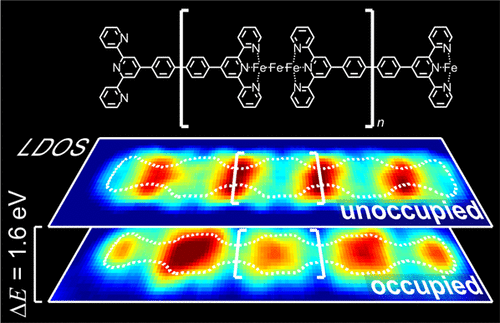Our official English website, www.x-mol.net, welcomes your
feedback! (Note: you will need to create a separate account there.)
Designing Optoelectronic Properties by On-Surface Synthesis: Formation and Electronic Structure of an Iron–Terpyridine Macromolecular Complex
ACS Nano ( IF 15.8 ) Pub Date : 2018-06-18 00:00:00 , DOI: 10.1021/acsnano.8b01026 Agustin Schiffrin 1, 2, 3 , Martina Capsoni 1 , Gelareh Farahi 1 , Chen-Guang Wang 4 , Cornelius Krull 2 , Marina Castelli 2 , Tanya Roussy 1 , Katherine A. Cochrane 5 , Yuefeng Yin 2, 3, 6 , Nikhil V. Medhekar 3, 6 , Michael Fuhrer 2, 3 , Adam Q. Shaw 1 , Wei Ji 4 , Sarah A. Burke 1, 5, 7
ACS Nano ( IF 15.8 ) Pub Date : 2018-06-18 00:00:00 , DOI: 10.1021/acsnano.8b01026 Agustin Schiffrin 1, 2, 3 , Martina Capsoni 1 , Gelareh Farahi 1 , Chen-Guang Wang 4 , Cornelius Krull 2 , Marina Castelli 2 , Tanya Roussy 1 , Katherine A. Cochrane 5 , Yuefeng Yin 2, 3, 6 , Nikhil V. Medhekar 3, 6 , Michael Fuhrer 2, 3 , Adam Q. Shaw 1 , Wei Ji 4 , Sarah A. Burke 1, 5, 7
Affiliation

|
Supramolecular chemistry protocols applied on surfaces offer compelling avenues for atomic-scale control over organic–inorganic interface structures. In this approach, adsorbate–surface interactions and two-dimensional confinement can lead to morphologies and properties that differ dramatically from those achieved via conventional synthetic approaches. Here, we describe the bottom-up, on-surface synthesis of one-dimensional coordination nanostructures based on an iron (Fe)-terpyridine (tpy) interaction borrowed from functional metal–organic complexes used in photovoltaic and catalytic applications. Thermally activated diffusion of sequentially deposited ligands and metal atoms and intraligand conformational changes lead to Fe–tpy coordination and formation of these nanochains. We used low-temperature scanning tunneling microscopy and density functional theory to elucidate the atomic-scale morphology of the system, suggesting a linear tri-Fe linkage between facing, coplanar tpy groups. Scanning tunneling spectroscopy reveals the highest occupied orbitals, with dominant contributions from states located at the Fe node, and ligand states that mostly contribute to the lowest unoccupied orbitals. This electronic structure yields potential for hosting photoinduced metal-to-ligand charge transfer in the visible/near-infrared. The formation of this unusual tpy/tri-Fe/tpy coordination motif has not been observed for wet chemistry synthetic methods and is mediated by the bottom-up on-surface approach used here, offering pathways to engineer the optoelectronic properties and reactivity of metal–organic nanostructures.
中文翻译:

通过表面合成设计光电性质:铁-吡啶吡啶高分子配合物的形成和电子结构
应用于表面的超分子化学方法为有机-无机界面结构的原子尺度控制提供了引人注目的途径。在这种方法中,吸附物-表面的相互作用和二维约束可能导致形态和性质与通过方法获得的形态和性质显着不同。常规的合成方法。在这里,我们描述了自下而上的,基于从光伏和催化应用中使用的功能性金属-有机络合物中借来的铁(Fe)-吡啶(tpy)相互作用的一维配位纳米结构的表面合成。顺序沉积的配体和金属原子的热活化扩散以及配体内部构象变化导致Fe–tpy配位并形成这些纳米链。我们使用低温扫描隧道显微镜和密度泛函理论阐明了系统的原子尺度形态,表明在面对的,共面的tpy基团之间存在线性的三铁键。扫描隧道光谱揭示了最高的占据轨道,并且位于Fe节点的状态起了主要作用,和配体状态主要是造成最低的未占用轨道。这种电子结构产生了在可见/近红外中承载光诱导的金属到配体电荷转移的潜力。在湿化学合成方法中尚未观察到这种异常的tpy / tri-Fe / tpy配位基序的形成,并且通过此处使用的自下而上的表面方法来介导,从而为工程化金属的光电特性和反应性提供了途径。有机纳米结构。
更新日期:2018-06-18
中文翻译:

通过表面合成设计光电性质:铁-吡啶吡啶高分子配合物的形成和电子结构
应用于表面的超分子化学方法为有机-无机界面结构的原子尺度控制提供了引人注目的途径。在这种方法中,吸附物-表面的相互作用和二维约束可能导致形态和性质与通过方法获得的形态和性质显着不同。常规的合成方法。在这里,我们描述了自下而上的,基于从光伏和催化应用中使用的功能性金属-有机络合物中借来的铁(Fe)-吡啶(tpy)相互作用的一维配位纳米结构的表面合成。顺序沉积的配体和金属原子的热活化扩散以及配体内部构象变化导致Fe–tpy配位并形成这些纳米链。我们使用低温扫描隧道显微镜和密度泛函理论阐明了系统的原子尺度形态,表明在面对的,共面的tpy基团之间存在线性的三铁键。扫描隧道光谱揭示了最高的占据轨道,并且位于Fe节点的状态起了主要作用,和配体状态主要是造成最低的未占用轨道。这种电子结构产生了在可见/近红外中承载光诱导的金属到配体电荷转移的潜力。在湿化学合成方法中尚未观察到这种异常的tpy / tri-Fe / tpy配位基序的形成,并且通过此处使用的自下而上的表面方法来介导,从而为工程化金属的光电特性和反应性提供了途径。有机纳米结构。











































 京公网安备 11010802027423号
京公网安备 11010802027423号